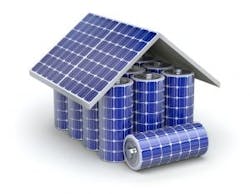CleanSpark Achieves Impressive Payback with Home Microgrid; Sets Stage for Expansion
CleanSpark has completed a home microgrid with an impressive one-year payback and is now turning its attention toward commercial & industrial (C&I) microgrids.
By Slavoljub Pantelic/Shutterstock.com
In an interview last week, Zachary Bradford, CleanSpark president, and founder Michael Firenze described the new project and the company’s plans for expansion.
Located in southern California, the residential microgrid gives CleanSpark some bragging rights.
For one, the microgrid is expected to achieve a quick payback when stacked up against utility rates.
For another, it shows that microgrids can serve typical homes. Home microgrids remain rare, but those that are built tend to be in large, high-end estates or in low-income housing that receives substantial incentives. CleanSpark’s microgrid serves a 2,900 square foot, family-of-four-style home.
“It’s a standard house, single story. Nothing exorbitant. This is a very normal family,” said Firenze.
The house is on well water, so by installing the microgrid, the family achieves both energy and water security.
The quick payback came in part because the house is remote and the homeowners would have paid high charges to connect to San Diego Gas & Electric’s grid. Other, not-so-remote home microgrids installed by CleanSpark, have achieved a payback of four to seven years, according to the company.
The fully off-grid microgrid also gained a “healthy portion” of its one-year payback because CleanSpark’s microgrid controller, working with a Nest thermostat, is programmed to learn occupant behavior and adjust supply decisions accordingly, said Bradford.
For example, if power use in the home typically spikes at 4 p.m., the system observes the pattern, and then may choose another time of day to take on certain tasks, so that the solar panels are free to serve the household during the period of high demand. For example, it may charge batteries or run water pumps earlier in the day when the household uses less electricity.
The microgrid uses 12.4 kW of mounted solar photovoltaics and 20.4 kW of lithium ferrous phosphate energy storage, supplied by SimpliPhi Power, and an 11 kW natural gas emergency backup genset, supplied by Generac.
Together, the energy systems create nested microgrids with triple redundancy. So in addition to achieving an estimated hundreds of thousands of dollars in savings, the project also provides exceptionally reliable power, according to CleanSpark.
“As the cost of energy storage continues to come down, we believe the application of microgrid solutions to the residential market will continue to increase, and we are well-positioned with a robust offering to capture a fair share of the opportunities,” said Matthew Schultz, CleanSpark CEO, in a statement released by the company.
Military, REIT microgrids ahead for CleanSpark
But pursuing the home microgrid market is only part of the company’s game plan. Like many microgrid developers, CleanSpark sees a larger play in the C&I microgrid market.
“A big reason we went into the residential space was to prove the merits of the controller in a scalable situation as we are approaching our true focus, which is in the commercial and industrial space, along with the military,” Bradford said.
CleanSpark is now finalizing a contract for a microgrid in a data center at Marine Corps Base Camp Pendleton in San Diego County.
The company also is handling design and engineering for a Real Estate Investment Trust (REIT) with a portfolio of about 200 properties nationwide. CleanSpark is designing a solution for the REIT’s entire portfolio, and will pick the top three projects to roll out over the next 12 months. The three projects are expected to range in size from $5 to $19.5 million.
CleanSpark has the right-of-first-refusal to develop the microgrids for the REIT’s entire portfolio. “Over 24 months we hope to roll out between 9 and 12 microgrids for this company,” Bradford said.
Located in San Diego, CleanSpark was acquired last year in a $36 million deal by Stratean, known for its stratified downdraft gasifier.
Track CleanSpark and other microgrid companies by subscribing to the Microgrid Knowledge newsletter. It’s free.







